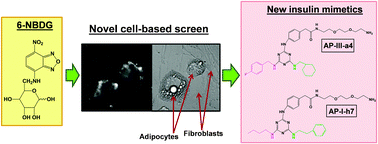There is an urgent need to discover new compounds that effectively treat diabetes by mimicking the action of insulin (insulin mimetics). Traditional approaches to studying anti-diabetic agents in cells are inconvenient for screening chemical libraries to identify insulin mimetics. 2-(N-(7-Nitrobenz-2-oxa-1,3-diazol-4-yl)amino)-2-deoxyglucose (2-NBDG) and 6-NBDG are fluorescent analogues of glucose that could be employed in screening. However, there are no published data about the use of these analogues to identify new insulin mimetics. We have developed a screening system based on 6-NBDG using 3T3-L1 adipocytes in a 96-well culture plate format. 6-NBDG was found to produce a larger signal than 2-NBDG in this screening system. 6-NBDG uptake in 3T3-L1 adipocytes was sensitive to insulin, known insulin mimetics, inhibitors of glucose transport and insulin-sensitizing compounds. To validate our screening system, a chemical library of 576 tagged, triazine-based small molecules was screened. The screening results were identical to that obtained from a commercial enzyme-based glucose assay. Two inducers of glucose uptake were shown to be non-cytotoxic and confirmed as insulin mimetic compounds by their inhibition of epinephrine-stimulated free fatty acid release from adipocytes. These novel insulin mimetics functioned at a markedly lower concentration than two widely studied insulin mimetics, zinc(II) complexes and vanadium compounds, and also showed novel, beneficial effects on endothelial cell function (a key determinant of secondary complications in diabetes). The discovery of new insulin mimetics using 6-NBDG validates the use of this probe in the development of large-scale, cell-based screening systems based on the uptake of fluorescent-tagged glucose analogues. This research should aid the development of novel strategies to discover new drugs and drug targets for combating the increasing prevalence of diabetes.

You have access to this article
 Please wait while we load your content...
Something went wrong. Try again?
Please wait while we load your content...
Something went wrong. Try again?


 Please wait while we load your content...
Please wait while we load your content...